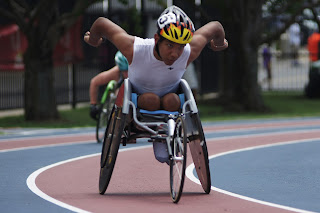Associated Press
WASHINGTON – Students with disabilities must be given a fair shot to play on a traditional sports team or have their own leagues, the Education Department says.
Disabled students who want to play for their school could join traditional teams if officials can make “reasonable modifications” to accommodate them. If those adjustments would fundamentally alter a sport or give the student an advantage, the department is directing the school to create parallel athletic programs that have comparable standing to traditional programs.
The groundbreaking order is reminiscent of the Title IX expansion of athletic opportunities for girls and women four decades ago and could bring sweeping changes to school budgets and locker rooms for years to come.
Activists cheered the changes.
“This is a landmark moment for students with disabilities. This will do for students with disabilities what Title IX did for women,” said Terri Lakowski, who for a decade led a coalition pushing for the changes. “This is a huge victory.”
It’s not clear whether the new guidelines will spark a sudden uptick in sports participation. There was a big increase in female participation in sports after Title IX guidance instructed schools to treat female athletics on par with male teams. That led many schools to cut some men’s teams, arguing that it was necessary to be able to pay for women’s teams.
Education Department officials emphasized they did not intend to change sports traditions dramatically or guarantee students with disabilities a spot on competitive teams. Instead, they insisted schools may not exclude students based on their disabilities if they can keep up with their classmates.
Federal laws, including the 1973 Rehabilitation Act and the Individuals With Disabilities Education Act, require states to provide a free public education to all students and prohibit schools that receive federal money from discriminating against students with disabilities. Going further, the new directive from the Education Department’s civil rights division explicitly tells schools and colleges that access to interscholastic, intramural and intercollegiate athletics is a right.
The department suggests minor accommodations to incorporate students with disabilities onto sports teams. For instance, track and field officials could use a visual cue for a deaf runner to begin a race.
Some states already offer such programs. Maryland, for instance, passed a law in 2008 that required schools to create equal opportunities for students with disabilities to participate in physical education programs and play on traditional athletic teams. And Minnesota awards state titles for disabled student athletes in six sports.
Increasingly, those with disabilities are finding spots on their schools’ teams.
“I heard about some of the other people who joined their track teams in other states. I wanted to try to do that,” said Casey Followay, 15, of Wooster, Ohio, who competes on his high school track team in a racing wheelchair.
Current rules require Followay to race on his own, without competitors running alongside him. He said he hopes the Education Department guidance will change that and he can compete against runners.
“It’s going to give me the chance to compete against kids at my level,” he said.
Some cautioned that progress would come in fits and starts initially.
“Is it easy? No,” said Brad Hedrick, director of disability services at the University of Illinois at Urbana-Champaign and himself a hall-of-famer in the National Wheelchair Basketball Association. “In most places, you’re beginning from an inertial moment. But it is feasible and possible that a meaningful and viable programming can be created.”

No comments:
Post a Comment